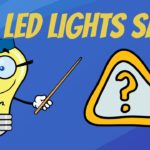LED lights have become the de facto light source for the energy, environmental, and financially conscious. But are LED lights safe? Let’s see what the research says…or doesn’t.
Most Toolbox DIY videos on LED lights have at least one comment warning us that LED lights are dangerous and should not be installed in your home. Many of these claims sound plausible, but are they true? Are LED lights safe? The research was surprising and disappointing. Let’s see what we found…
5 Claims About LED Lights
Okay so what did our research uncover? We basically found five major themes or claims among critics and various studies that suggest LED lights are bad for our eyes. One of the most disappointing things we discovered was that most critics of LED lights like to treat all light sources equally. So if they find a study about how bad LED screens are for our eyes, they assume that all LEDs lights must have the same negative impacts.
Let us start by saying that the focus of this video is on the potential dangers of overhead and ambient LED light sources NOT the dangers of LED screens such as laptops, tablets, and phones. LED lights in our home have significant energy and cost benefits and we all deserve to know…”Are LED Lights Safe?”
Here are the five most common claims we found:
- LED lights contain too much blue light
- Blue light interferes with your circadian rhythm
- Said blue light can result in damage to your eyes specifically accelerating age related macular degeneration
- LEDs contain no near-infrared light which is beneficial to your eyes
- There is a flicker in LED lights (which is not always noticeable) which can cause eye strain and headaches
Are These Claims About LEDs True?
The short answer is yes, no, and it’s complicated.
Blue Light
Let’s start with the claim that LED lights contain too much blue light. It is true that LEDs lights contain a high amount of blue light, but not all LED lights are created equal. A bright white light contains more blue than a warm white light. A 3000 kelvin color temperature LED has about 21% blue light. Is that a lot? Well, maybe. On a sunny day, the sun is putting out about 25% blue light. So is this claim really true? It’s subjective. So we consider this one “complicated”. Relative to other artificial light sources, LEDs do have higher amounts of blue light. But let’s move on to the other claims regarding blue light to see how much this really matters.
Circadian Rhythm
Next up is the claim that blue light has been proven to interfere with your circadian rhythm – that’s our 24 hour clock that helps us go to sleep and wake up relative to the cycle of the sun. This is 100% true. So blue light is starting to matter.
Blue Light Eye Damage
On the third claim, there have been some studies that strongly suggest and in some cases prove that blue light can cause oxidative damage to your eyes, along with inflammation, cell death, and increased change of age-related macular degeneration. While this claim would suggest that the answer to the question “are leds lights safe?” is a big fat NO, this claim that has very little supporting evidence that overhead or ambient LED light sources cause these issues.
We found one study of rats where they were subjected to overhead LED lights and it did result in more damage than the rats in the control group who were not exposed to LED lights. There’s one major difference with rats than humans though. Their eyes move independently unlike ours and they always have one eye looking up. So it’s not uncommon for a rat to be looking directly into an overhead light source. That’s not something us humans typically do. Many of the studies around this claim are related to LED screens. So when it comes to overhead LED lights, I’m going to evaluate this claim as mostly false.
Near-Infrared Light
Next up is the claim that LEDs contain no near-infrared light which is beneficial to our eyes. It is absolutely true that LED lamps used in overhead and ambient lights contain no near-infrared light. Does this really matter? Is near-infrared light good for our eyes? Our research says yes this is very likely. There have been a number of experiments using near-infrared light to help heal damaged eyes. Some researchers have pointed out that the sun contains near-infrared light and our exposure to the sun may help heal our eyes on a regular basis. It seems plausible to us that the sun’s near infrared light may help offset the damaging blue light of the sun – but that’s just unscientific speculation. We’re marking this claim “true”.
That Pesky Flicker
Last up is flicker. Some critics say LEDs should not be used because they flicker. This is probably the most ill-informed claim. All lights powered by A/C power have some level of flicker. Even an incandescent bulb has a small amount of flicker but it is usually not visually perceptible. Fluorescent lights flicker quite a bit. And some LEDs do flicker but not because of the LED light source itself. It’s due to the A/C to D/C converter built into either the lamp or the external driver. A good quality A/C to D/C converter will have no flicker. We consider this claim “false” but I will add the caveat that there should be a certification for LED lights that would measure flicker so we as consumers could make more informed decisions.
So Are LED Lights Safe?
Let’s summarize the claims and results and then decide if we need to immediately get rid of all our LED light sources.
- LEDs have too much blue light – somewhat to mostly true
- Blue light interferes with our circadian rhythm – true
- Blue light causes eye damage – undetermined when it comes to overhead lights
- No near-infrared light in LEDs – true
- LED lights flicker – false
Three trues, one false, and one undetermined. Are LED lights safe? Is it time to rethink LEDs in our homes? I think it’s time that we use LEDs wisely in our home and not jettison them altogether. If you are highly concerned about your eye health from the impacts of LEDs, start with your screens first. Those are the biggest contributors to modern eye issues in our opinion. But are precautions you can take when it comes to using overhead and ambient LED lights.
Tips for Safe LED Light Use
- Use warm white LEDs in most parts of your home. Only use bright white LEDs in the garage and the workshop where you need to be alert and have a good light source to safely carry out tasks.
- Avoid LED lamps in lights that are not overhead. Convert back to incandescent and halogen for lights that are at or near eye-level. So all the table lamps and pendant lights should not use LEDs.
- Reconsider your screen habits first before replacing your overhead lights. If you aren’t taking advantage of night light mode on your screens or if you aren’t using blue blocker software or glasses, you are getting high intensity blue light exposure on a regular basis.
- For recessed lighting, consider deep baffle LED lights. These reduce glare and thus the amount of direct light into our eyes.
- Buy high quality LEDs so you avoid LEDs that flicker. If you detect or even think you detect flicker, return those lights for another brand.
- Supplement sunlight during the day. Open your shades or blinds. Don’t let artificial light be your only source of light when the sun is out.
- Lastly, spend at least an hour outside every day! It’s a great way to get that beneficial near infrared light not to mention all the other health and emotional benefits it provides.
Final Thoughts
Are LED lights safe? In our opinion, when used wisely, LED lights are safe to use. We just have to be smart about how we use them, when we use them, and where we use them. It’s an evolving technology that has many benefits. Here at Toolbox DIY we’re keeping an eye (pun intended) on the technology and the research to make sure we use LEDs safely!
Thanks for joining Toolbox DIY today.








